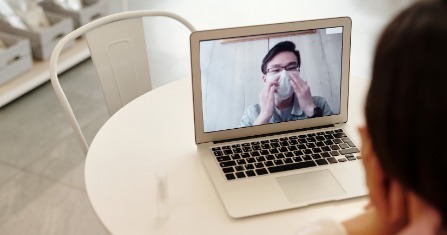As providers are scrambling to transition in-person appointments online, they’re seeing the advantages and unexpected benefits of telemedicine. Here are five ways telemedicine is aiding in the fight against COVID-19.
1. Giving patients a virtual option for regular appointments reduces their risk of unnecessary exposure.
Normal health issues don’t stop for a pandemic. Moving appointments to a virtual setting can help doctors provide follow-up care for at-risk patients remotely, ensuring that patients aren’t accidentally exposed to COVID-19.
It also works the other way: patients who are worried they may be infected but don't need to go to the hospital can check in with their doctor through live video, without worrying about exposing others. It also eliminates the possibility of picking up COVID-19 at the hospital if it turns out they weren’t already infected.
2. Through remote appointments, quarantined healthcare providers can still care for patients.
If a healthcare provider is exposed to COVID-19 and must self-quarantine, or is at a higher risk of serious complications from COVID-19, telemedicine can provide them with a way to continue working.
Clinicians can conduct virtual appointments from home and still provide patients with a high level of care, while relieving some of the strain on the care teams on-location at the hospital.
3. Even in the hospital, clinicians can see patients remotely, conserving valuable Personal Protective Equipment (PPE).
Using telemedicine within the hospital itself can also prevent clinicians from being exposed to COVID-19. By setting doctors up with video-enabled devices, they can conduct examinations without ever entering a potential COVID-19 patient’s room, saving PPE for nurses and other caregivers who come in contact with patients.
4. Telemedicine can help doctors see patients who would otherwise avoid making appointments.
While there are still many obstacles with how much insurance companies will agree to cover for remote appointments, telemedicine may reduce the cost of some appointments.
This could help attract patients who otherwise could not afford a doctor’s visit. Being able to expand into new demographics and provide them with quality care can help doctors better mitigate the spread of COVID-19.
5. Telemedicine appointments allow for new flexibility, discoveries, and creativity in patient care.
While the COVID-19 pandemic has changed our lives in many negative ways, there is a silver lining: it has illuminated the human capacity for creativity, resourcefulness, and discovery in the midst of tough circumstances.
Clinicians who previously assumed that their services could not be adapted to a telemedicine format are discovering that virtual appointments can give them a valuable insight into patients’ home lives, helping them come up with therapy ideas specifically suited to each patient’s home environment.
Sahana Baker-Malone, a pediatric occupational therapist, told The Mercury News: “We’re getting to participate in their normal life as opposed to bringing them into our clinic, where we see kind of constructed sessions.”



 Your new post is loading...
Your new post is loading...








Se le ofrece medicación sin receta, Farmacia España. – una de las farmacias más confiables de España, con más de 20 años de experiencia dispensando medicamentos de calidad
https://drogaspoderosas.com/producto/comprar-adderall-xr/
https://drogaspoderosas.com/producto/comprar-adipex-en-linea/
https://drogaspoderosas.com/producto/comprar-ambien-en-linea/
https://drogaspoderosas.com/producto/comprar-ativan/
https://drogaspoderosas.com/producto/comprar-blue-xanax/
https://drogaspoderosas.com/producto/comprar-botox-en-linea/
https://drogaspoderosas.com/producto/comprar-codeina/
https://drogaspoderosas.com/producto/comprar-demerol-50mg-ml/
https://drogaspoderosas.com/producto/comprar-diazepam-en-linea/
https://drogaspoderosas.com/producto/comprar-dilaudid-8mg/
https://drogaspoderosas.com/producto/comprar-efedrina-hcl-30mg/
https://drogaspoderosas.com/producto/comprar-endocet-en-linea/
https://drogaspoderosas.com/producto/comprar-green-xanax/
https://drogaspoderosas.com/producto/comprar-hidrocodona-en-linea/
https://drogaspoderosas.com/producto/comprar-metadona-10mg/
https://drogaspoderosas.com/producto/comprar-morfina-15mg/
https://drogaspoderosas.com/producto/comprar-opana-en-linea/
https://drogaspoderosas.com/producto/comprar-stilnox-en-linea/
https://drogaspoderosas.com/producto/comprar-oxicodona-en-linea/
https://drogaspoderosas.com/producto/comprar-oxycontin-en-linea/
https://drogaspoderosas.com/producto/comprar-percocet-10mg-325mg/
https://drogaspoderosas.com/producto/comprar-rohipnol-2mg/
https://drogaspoderosas.com/producto/comprar-stilnox-en-linea/
https://drogaspoderosas.com/producto/comprar-suboxone-8mg/
https://drogaspoderosas.com/producto/comprar-subutex-8mg/
https://drogaspoderosas.com/producto/comprar-tableta-demerol/
https://drogaspoderosas.com/producto/comprar-vicodin-en-linea/
https://drogaspoderosas.com/producto/comprar-vyvanse-en-linea/
https://drogaspoderosas.com/producto/comprar-xanax-2mg/
https://drogaspoderosas.com/producto/compre-ritalin-en-linea/
https://drogaspoderosas.com/producto/parches-de-fentanilo/